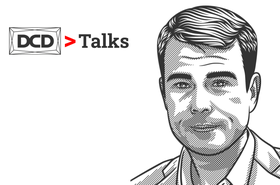Ask any senior executive in the data center industry what superpower they would choose if they could, and they would tell you they want to be able to see into the future.
We can make predictions and best guesses, but current estimates are suggesting that this year global IT spend will reach $227 billion and is only going to keep increasing.
But these best guesses are just that: guesswork. All we really know is that demand is likely to increase and that the increase will probably be significant and extremely hard to match in terms of the supply chain, both raw products and skilled workers.
At our recent San Francisco DCD>Connect event, we sat down with CBRE’s director, Colin DeLacy, to discuss how CBRE is tackling these challenges.
“Data centers are really a system of systems,” said DeLacy. “It’s everything from the network and telecommunications, to power, to operations and management, which includes people, processes, and technology. It includes the IT systems and the civic systems in place, and all of those [systems] must work to have a successful venture.”
In other words, CBRE sees the industry in all its complexity, a microcosm of society as a whole, with many interlinking parts dependent on one another for continued success.
What this means, however, is that as demand grows, it is not so simple to provide for it. There are many elements that must evolve and adapt. According to DeLacy, this supply-demand paradigm should be viewed from an opportunity cost perspective above all else.
Data center operators therefore must ask themselves several questions to keep up with a changing industry.
“What's proprietary? What complex technology should be kept in-house? What's repeatable? What can be standardized? And where can I plug into a resource pool that may even be able to ‘uplevel’ key functions to help me meet those business goals?” asked DeLacy.
Another important question relates to the workforce, which is how can you get the skilled staff you need?
According to research by the Uptime Institute, global data center staff requirements are projected to grow globally from about two million full-time employee equivalents in 2019 to nearly 2.3 million in 2025.
So where are we going to find 300,000 skilled workers? Let’s start with engineering in the broadest sense of the word.
In 2019, 62 percent of engineering students in the UK went on to work in engineering roles. While a significant proportion, that statistic still leaves at least 38 percent pursuing other careers. And of those 62 percent, how many end up in data centers?
This is a question that does not yet have an answer, and while 2019 now seems like a distant past, there is little cause to think these numbers have drastically changed in the past three years.
With no guarantee that these skilled workers will go on to work as engineers, nor that they will choose to do so in a data center setting, companies need to be thinking about how they will appeal to future generations of graduates.
“At the front end, we consider how to recruit and attract talent. How do we get the right folks with the right skills, behaviors, and competencies?” says DeLacy. “Once those folks are hired, how do we train? How do we certify? How do we maximize value for both that person and the organization?”
These are just some of the practical considerations for hiring staff, but it isn’t only the front-end thinking that needs to be in place.
“Everyone is facing staffing challenges. But this goes beyond the front end of attracting talent. It’s also the need to maximize that investment from a career growth and development point of view. Returning resources: that's when value is maximized. Having a long-term path that allows talent to grow within an organization is so important,” explained DeLacy.
Companies, like those skilled workers they are attempting to attract, need to be thinking long-term.
Today’s workforce has options, which means they also have power. The data center industry needs to be the best choice, which can be achieved by providing an option with tangible longevity. In practice, this looks like having progression within job roles, offering ongoing training, introducing new technologies when appropriate, offering remote working, and so on.
When it comes to achieving this on an international scale – and with forecasts like the Uptime Institute’s indicating investments in IT infrastructure will not only increase but diversify in location – increasing your talent pool globally is a necessity, but also presents additional complexities.
“When you're looking at market expansion or entering a global market, you need to have an HR system in place. Each country has unique laws and regulations that must be followed – all of which can impact the ability to deliver capacity on time.”
The expanding industry is non-linear. It is not a graph, it is a big bang, a sudden rush outward in every direction from one moment in time. What CBRE has realized, is that unless your approach is all-encompassing, you will forever be playing catch up.
More from CBRE
-

Sponsored Future proofing your supply chain (the human way)
Examining the human element of the data center supply chain
-

Sponsored Sustainability: The bigger picture
Taking a holistic approach to sustainability in the data center
-

DCD>Talks Management & Operations with Colin Delacy, CBRE
Dive into management & operations with this DCD>Talk from our live DCD>Connect Silicon Valley event

